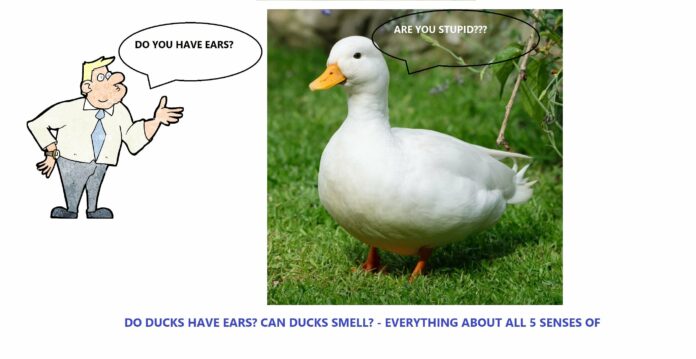I have been wondering if do ducks have ears. Did you realize that ducks possess extraordinary senses? Indeed! Similar to human beings, they have five senses that aid them in surviving and enjoying their surroundings.
Waterfowls such as ducks and geese have the same five senses that we have. But in these waterfowls birds, these senses are specially designed to work well in the places where they live.
Let’s learn how sharp and useful each of their five senses is and how they help them stay safe and strong during their amazing trips every year. Also get your question “do ducks have ears” answered in the article below.
Sight
Waterfowls like ducks and geese use their eyes more than any other sense, whether flying in the sky or swimming in the marsh. Their eyes are built differently than ours, and they can see things much better and from much further away. They can even see colors we can’t see, like ultraviolet and red.
Waterfowls have special eyes on the sides of their head, giving them a wide view of everything around them. But this means that waterfowls can’t see things as well up close and in-depth as we do.
To make up for this, waterfowls quickly move their head back and forth to see an object with each eye, which helps them build a picture that seems to have more depth.
Waterfowls need their great eyesight for many important things, like finding food and places to live and avoiding danger from predators or hunters.
You might have noticed that geese and ducks can fly away quickly if they see something that makes them worried like a hunter moving or the shine from a gun. waterfowls’ sharp vision helps them stay safe and keep out of harm’s way.
Some types of Waterfowls, like mergansers, use their eyes to help them catch food. They hunt for things like small fish that swim fast in the water.
To help them do this, their eyes are located closer to the front of their head. This special placement helps waterfowl see and catch their food better.
ALSO READ: How and Where Do Ducks Sleep?- You’ll Be Surprised To Know
Sound
Waterfowls like ducks and geese also use their ears a lot, especially after their eyes. Their ears are hidden under soft feathers and positioned just behind and below their eyes.
These soft feathers help protect the ears and keep them from hearing loud noises from the wind when the birds are flying.
Like ducks and geese, Waterfowls talk to each other using different sounds. This is really important for the safety and survival of the waterfowls. They listen to each other’s calls to stay close to their mates and babies, even when surrounded by many other birds making noise.
They also use their good hearing to find food when they dive underwater. While they are still inside their eggs, baby Waterfowls can already hear the sound of their mother’s voice.
This is called imprinting and helps them recognize her when they are born. The baby birds also talk to each other inside the eggs so they can get all hatch simultaneously. That way, they can quickly follow their mother’s calls and leave the nest together, usually within 24 hours of birth.
So, Do Ducks Have Ears?
Yeah, ducks have ears, but you might not be able to see them easily because they are hidden by feathers. Their ears are on the sides of their head, near their eyes.
The part of the ear that you can see is called the auditory meatus, and it’s really small. But don’t worry, even though you can’t see their ears easily, ducks still have an inner ear that helps them hear sounds.
Check the video below where a girl shows that ducks do have ears:
Touch
The sense of touch helps Waterfowls like ducks and geese feel different things, like temperature, pressure, and the texture of what they touch. This sense is really important when they are looking for food.
Some Waterfowls use their beaks to feel for food in murky water or in the mud at the bottom of wet places, where it’s too dark to see.
Waterfowls have special places on their beaks called Herbst corpuscles that help them feel even the softest foods. Other Waterfowls have less feeling in their feet, which makes them not mind standing on cold snow or ice for a long time.
Taste
Waterfowls, like ducks and geese, don’t have a very strong sense of taste compared to other animals, like people and fish. Taste is when your mouth senses different flavors from food. The more taste buds you have, the better you can taste things.
Waterfowls only have about 400 taste buds, while people have 9,000 and fish have 100,000. This means they might be unable to taste things like some other animals.
However, waterfowls do have some taste buds, which means they can still tell the difference between different flavors.
For example, scientists have made chemicals that taste bad for Canada geese to keep them from eating crops and grass. These chemicals taste like grape soda and make the crops and grass taste yucky to the geese.
ALSO READ: Don’t feed These To Your Ducks – What Do Ducks Eat?
Smell
People used to think that Waterfowls, like ducks and geese, have the weakest sense of smell. While their sense of smell might not be as strong as dogs or some other birds, they can still smell things to some degree.
Studies show that geese can tell the difference between plants they can eat and other plants just by their smell. Also, ducks have special glands that make scents used for mating and recognizing other ducks of their own kind.
Waterfowls like ducks and geese use all five of their senses to survive and do well in different places. For example, a wood duck flies really fast through the branches of trees.
A blue-winged teal travels from a place called the Prairie Pothole Region to the Caribbean. A long-tailed duck goes diving deep into the ocean to find food.
Each of these Waterfowl birds uses its senses to help them succeed in these different environments. The next time you see a Waterfowls, think about how they use its eyes, ears, sense of touch, taste, and smell to understand the world around them.

Do Ducks Have Ears?
Yes, ducks do have ears, although they are not easily visible. They are located on the sides of the head and behind the eyes and are covered with feathers. The external ear opening of ducks, called the auditory meatus, is small and difficult to see, but it leads to the inner ear, where sound is processed.
RELATED POSTS:
Do Ducks Have Teeth? Everything You Need to Know About Duck Teeth
14 Simple Tricks to Keep Ducks Away From Your Pool




